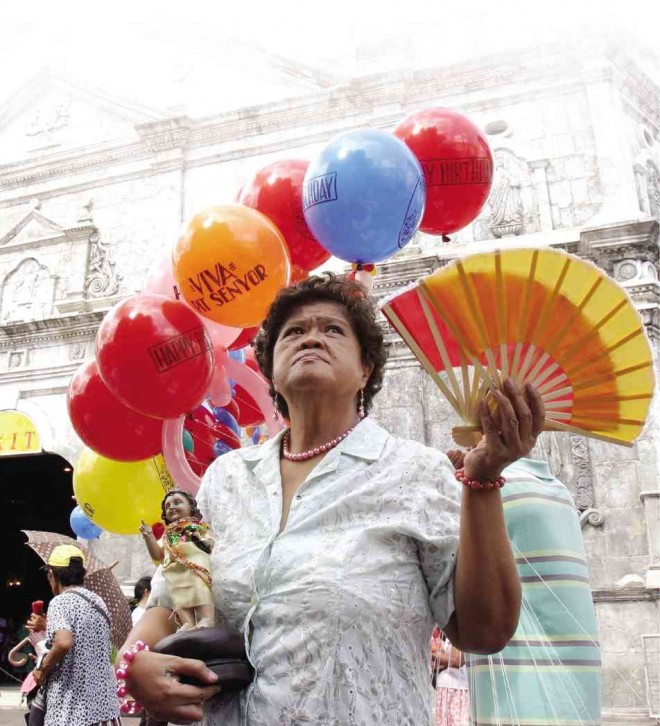
FAITH is immeasurable for devotees of Sto. Niño, like this woman who had come all the way from Pampanga to take part in the Sinulog during the festival’s holding in 2009. JUNJIE MENDOZA/CEBU DAILY NEWS
CEBU CITY—Maria Elena Gabutan, 56, was soaked in the early morning rain but didn’t mind staying at the Ouano wharf in Mandaue City.
Gabutan, of Barangay Lamac, Consolacion in northern Cebu, was deep in prayer while she held a small Sto. Niño image close to her heart.
She waved her right hand as she watched the images of the Sto. Niño and the Our Lady of Guadalupe being boarded into a waiting galleon for the annual fluvial procession.
“I was praying for a longer life,” said Gabutan who was diagnosed with stage 1 breast cancer.
Gabutan and over a hundred other devotees lined the Ouano wharf in Barangay Looc in Mandaue City for the sendoff of the two miraculous images who traveled by sea on their way back to the Basilica Minore del Sto. Niño in Cebu City.
The fluvial procession opens the daylong fiesta activities of the Sto. Niño which culminates with the afternoon solemn procession.
Pagasa placed northern Cebu and Cebu City under storm signal number 1 with wind velocity of 30 kph to 60 kph at 5 a.m. yesterday.
Vessels joining the fluvial procession were also warned of waves of 1.5 meters to 2.5 meters tall.
While it rained, waters at the Mactan Channel remained calm when the fluvial procession started at 6:55 a.m. and lasted for about an hour.
“Even if we are under storm signal number 1 and there’s been a gale warning, we continued to have fine weather so we went on with the fluvial procession,” said Rodolfo Villajuan, commander of the Philippine Coast Guard Cebu station.
Traslacion
The images of the Sto. Niño and the Our Lady of Guadalupe were transferred from the basilica to the National Shrine of St. Joseph’s in Mandaue City on Friday morning for the annual traslacion. Both images were made to stay at the national shrine for an overnight vigil.
A 4 a.m. Mass was celebrated by Fr. Benjamine Cortes on Saturday, after which hundreds of devotees brought the images to the Ouano wharf in Barangay Looc. They walked a kilometer from Barangay Centro, where the shrine is located, to the wharf.
The Sto. Niño image, which is a replica of the original image that Portuguese explorer Ferdinand Magellan brought to Cebu, and the image of the Our Lady of Guadalupe were loaded into a white painted galleon for the fluvial procession which followed a 8.6-kilometer route to Pier 1 in Cebu City.
Security personnel, dressed as Spanish sailors, escorted the two images.
The galleon traveled at a speed of 7 knots which is equivalent to a 40 kph to 50 kph travel on land.
A total of 106 boats, which included vessels and motor bancas, tailed the fluvial procession.
Most of the motor bancas were adorned with flowers and red and yellow flaglets.
While the fluvial procession was 55 minutes late than its 6 a.m. schedule, the galleon reached Pier 1 at 8 a.m. as scheduled.
Villajuan said organizers decided to increase the galleon’s speed from only five to six knots to seven knots to make sure that the galleon arrives on time.
Light to moderate rain fell shortly before the galleon left Ouano wharf and as it sailed through the Mactan Channel. This, however, did not prevent devotees from watching the fluvial procession, waving at the two images as they passed by.
Hundreds of people lined up the ports of Mandaue and Cebu City and Mactan Island on the other side of the Mactan Channel.
Others danced while many others lighted firecrackers and flew red and yellow balloons as the fluvial procession passed.
From Pier 1, the Sto. Niño and Our Lady of Guadalupe were brought back to the basilica on foot.
Basilica rector Fr. Jonas Mejares led the re-enactment of the first Mass at 9 a.m.
In his homily, Mejares thanked the people who crowded the basilica’s pilgrim center to witness the re-enactment of the first Mass and the baptism of King Humabon and Queen Juano despite Tropical Storm Amang.
“Hardships in life make us fully experience the goodness of God,” he said.
The images were again brought out of the basilica for the 1 p.m. procession which thousands of devotees joined, walking the 5.65 kilometer procession route.